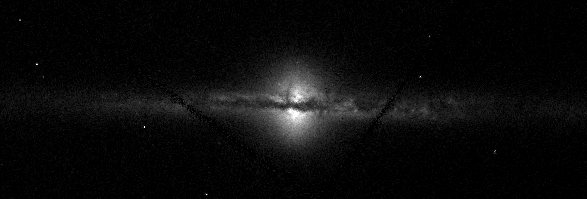
HST/WFPC2 image of the edge-on disk galaxy UGC10043, with a prolate bulge.

Below is a description of some of the work I have done and some of the projects I have participated in concerning disk galaxies, mostly early and intermediate types. Unfortunately, lack of time prevents me from putting on the web everything I am involved in, but my publications list (which is up-to-date) should alleviate this problem somewhat.
My interest in spiral galaxies centers around the issues of structure, dynamics, and evolution. I am especially interested in how bars can drive evolution in disks and how they may lead to the formation of a bulge, although this presupposes a general understanding of bar dynamics. My work typically proceeds in parallel, comparing targeted observations with detailed numerical modeling, and I am particularly interested in testing bar-buckling (i.e. bar-thickening) scenarios.
| Bar Diagnostics | Boxy Bulges | Gas Counter-Rotation | |||
| SAURON | M31 | NGC 7332 |
Bar Diagnostics:
During my PhD
thesis at MSSSO, I spent many
months working with Lia
Athanassoula (Observatoire de
Marseille) developing kinematic bar diagnostics for edge-on
disks. This is necessary because bars in edge-on spirals can not be
identified reliably using morphological arguments alone. We developed
many tools to detect the presence of an edge-on bar and constrain its
orientation, relying primarily on the kinematic signature of a bar in
the position-velocity diagram (PVD) of a barred spiral galaxy viewed
edge-on. Using a well-studied barred spiral galaxy mass model, we
briefly reviewed the orbital properties of two-dimensional
nonaxisymmetric disks and identified the main families of periodic
orbits. We then used those families as building blocks to model real
galaxies, and calculated the PVDs obtained for various realistic
combinations of periodic orbits and for a number of viewing angles. We
showed that the global structure of the PVD is a reliable bar
diagnostic in edge-on disks. Specifically, the presence of gaps in the
PVD between the signatures of the various periodic orbit families
follows directly from the nonhomogeneous distribution of the orbits in
a barred galaxy. Similarly, material in the two so-called forbidden
quadrants of the PVD results from the elongated shape of the
orbits. We also showed how the shape of the signatures from the
dominant x_1 and x_2 periodic orbit families can be used efficiently
to determine the viewing angle with respect to the bar, and to a
lesser extent to constrain the mass distribution of an observed
galaxy. We also addressed the limitations of these simplistic models
when interpreting observational data.
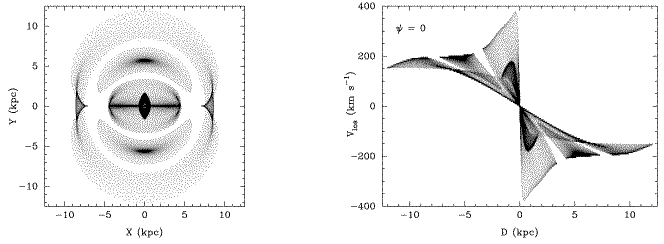
A paper this describing this work has appeared in Bureau, M., & Athanassoula, E. 1999, ApJ, 522, 686. You can also download it here in preprint format.
Lia Athanassoula (Observatoire de Marseille) and I also developed edge-on bar diagnostics relying on the gas kinematics, easily observed in late-type galaxies. We then used PVDs obtained from two-dimensional hydrodynamical simulations of the gas flow in the same barred galaxy potential. We showed that when a nuclear spiral is formed, the presence of a gap in the PVDs, between the signature of the nuclear spiral and that of the outer parts of the disk, reliably indicates the presence of a bar. This gap is due to the presence of shocks and inflows in the simulations, leading to a depletion of the gas in the outer bar region. If no nuclear spiral is present, only indirect arguments can be used to infer the presence of a bar. The shape of the signature of the nuclear spiral, and to a lesser extent that of the outer bar region, allows a determination of the orientation of the bar with respect to the line of sight. The presence of dust can also help to discriminate between viewing angles on either side of the bar. Simulations covering a large fraction of parameter space further constrain the bar properties and mass distribution of observed galaxies. The strongest constraint comes from the presence or absence of the signature of a nuclear spiral in the PVD.
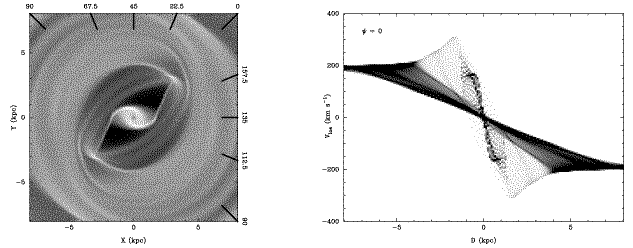
A paper this describing this work has appeared in Athanassoula, E., & Bureau, M. 1999, ApJ, 522, 699. You can also download it here in preprint format.
More recently, Lia Athanassoula (Observatoire de Marseille) and I also developed stellar kinematic bar diagnostics, allowing to probe the vertical structure of bars in early-type, gas-poor galaxies. Because stars are not constrained to periodic orbits, but can also move along quasi-periodic and chaotic orbits, the stellar models described above are too simplistic to be used in practice. We therefore used self-consistent 3D N-body simulations of bar-unstable disks for this study. Using Gauss-Hermite polynomials to describe the major-axis stellar kinematics of edge-on disks, a number of characteristic bar signatures were identified: 1) a major-axis light profile with a quasi-exponential central peak and a plateau at moderate radii (Freeman Type II profile); 2) a ``double-hump'' rotation curve; 3) a sometime flat central velocity dispersion peak with a plateau at moderate radii and occasional local central minimum and secondary peak; 4) an h3-V correlation over the projected bar length. All those kinematic features are spatially correlated and can be traced back to the orbital structure of barred disks. They thus provide a reliable and easy-to-use tool to identify (gas-poor) edge-on bars. Interestingly, the signatures are all produced without dissipation and are increasingly realized to be common in spirals, lending support to bar-driven evolution scenarios for bulge formation. Although not uniquely related to triaxiality, line-of-sight velocity distributions with a high velocity tail (i.e. an h3-V correlation) appear as particularly promising tracers of bars. The stellar kinematic features identified grow in strength as the bar evolves and vary little for small inclination variations. Many can be used to trace the bar length.
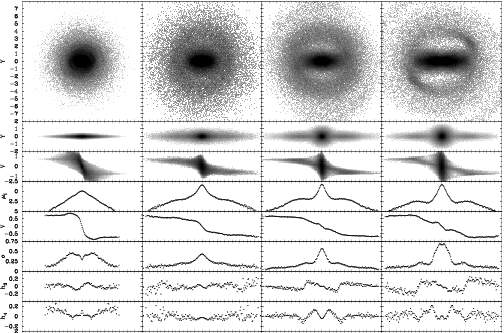

A paper this describing this work has appeared in Bureau, M., & Athanassoula, E. 2005, ApJ, 626, 159. You can also download it here in preprint format.
Boxy/Peanut-Shaped Bulges:
The last part of my
PhD thesis consisted of an extensive and systematic observational
study of the relationship between bars and boxy/peanut-shaped (B/PS)
bulges, in collaboration with Ken
Freeman (MSSSO). B/PS bulges
are present in at least 40% of disk galaxies and may thus represent a
crucial stage in their evolution and the formation of bulges. We first
reviewed and discussed the various proposed mechanisms forming B/PS
bulges, focusing on accretion and bar-buckling scenarios. Using the
gaseous bar diagnostics discussed
above, we looked for bars in a large sample of edge-on spiral galaxies
with a B/PS bulge and in a smaller control sample of edge-on spirals
with more spheroidal bulges. We presented the position-velocity
diagrams (PVDs) of the ionized gas obtained from optical long-slit
spectroscopy (SSO 2.3-m
telescope) and showed that almost all B/PS bulges are due to a
thick bar viewed edge-on, while only a few extreme cases may be due to
the accretion of external material. This strongly supports the
bar-buckling mechanism for the formation of B/PS bulges. None of the
galaxies in the control sample showed evidence for a bar, which
suggests conversely that bars are generally B/PS. We considered the
effects of dust in the disk of the galaxies but concluded that it did
not affect our results significantly. Unusual emission-line ratios
correlating with kinematic structures are observed in many objects,
and we argued that this is consistent with the presence of strong bars
in the disk of the galaxies. As expected from N-body simulations, the
boxy-peanut transition appears to be related to the viewing angle, but
more work is required to derive the precise orientation of the bars in
those bulges. The reliable identification of bars in edge-on spiral
galaxies opens up for the first time the possibility of studying the
vertical structure of bars observationally.
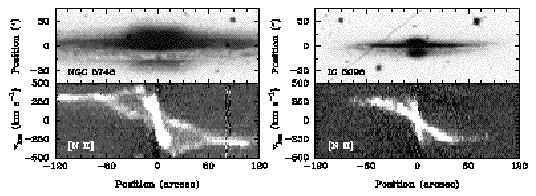
A paper describing this work has appeared in Bureau, M., & Freeman, K. C. 1999, AJ, 118, 126. You can also download it here in preprint format.
Together with Aeree Chung (Columbia University), I also analysed the stellar kinematics of the same sample of edge-on spiral galaxies with a B/PS bulge. Profiles of the mean stellar velocity, the velocity dispersion, as well as the asymmetric (h3) and symmetric (h4) deviations from a pure Gaussian were derived for all objects. Comparing these profiles with the stellar kinematic bar diagnostics developed from N-body simulations, we found bar signatures in 24 of our 30 sample galaxies (80%). Galaxies with a B/PS bulge typically show a double-humped rotation curve with an intermediate dip or plateau. They also frequently show a rather flat central velocity dispersion profile accompanied by a secondary peak or plateau, and numerous galaxies have a local central dispersion minimum (40%). The h3 profiles display up to three slope reversals. Most importantly, h3 is normally correlated with V over the presumed bar length, contrary to expectations from axisymmetric disks. These characteristic bar signatures strengthen the case for a close relationship between B/PS bulges and bars and leave little room for other explanations of the bulges' shape. We also found that h3 is anticorrelated with V in the very center of most galaxies (60%), indicating that these objects additionally harbor cold and dense decoupled (quasi-)axisymmetric central stellar disks, which may be related to the central light peaks. These central disks coincide with previously identified star-forming ionized-gas disks (nuclear spirals) in gas-rich systems, and we argued that they formed out of gas accumulated by the bar at its center through inflow. As suggested by N-body models, the asymmetry of the velocity profile (h3) appears to be a reliable tracer of asymmetries in disks, allowing to discriminate between axisymmetric and barred disks seen in projection. B/PS bulges (and thus a large fraction of all bulges) appear to be made up mostly of disk material, which has acquired a large vertical extent through bar-driven vertical instabilities. Their formation is thus probably dominated by secular evolution processes rather than merging.
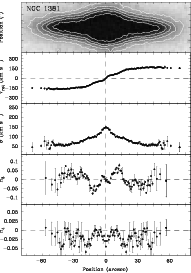
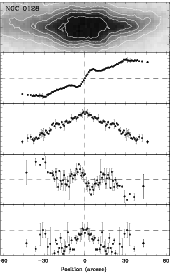
A paper describing this work has appeared in Chung, A., & Bureau, M. 2004, AJ, 127, 3192. You can also download it here in preprint format.
Together with Giuseppe Aronica and Ralf-Juergen Dettmar (Ruhr-Universitaet Bochum), Lia Athanassoula and Albert Bosma (Observatoire de Marseille), and Ken Freeman (MSSSO), I also obtained K-band observations of the same sample of 30 edge-on spiral galaxies with a boxy/peanut-shaped (B/PS) bulge (SSO 2.3-m telescope). K-band best traces the dominant luminous galactic mass and is minimally affected by dust. Galaxies with a B/PS bulge tend to have a more complex morphology than galaxies with other bulge types, more often showing centered or off-centered X structures, secondary maxima along the major-axis and spiral-like structures, all of which appear to trace the major orbit families of three-dimensional bars. The surface brightness profiles of galaxies with a B/PS bulge are also more complex, typically containing 3 or more clearly separated regions, including a shallow or flat intermediate region (Freeman Type II profiles). The breaks in the profiles offer convincing evidence for bar-driven transfer of angular momentum and radial redistribution of material. The profiles further suggest a rapid variation of the scaleheight of the disc material, contrary to conventional wisdom but again as expected from the vertical resonances and instabilities present in barred discs. Similarly to other recent work but contrary to the standard `bulge + disc' model, we thus proposed that galaxies with a B/PS bulge are composed of a thin concentrated disc (a disc-like bulge) contained within a partially thick bar (the B/PS bulge), itself contained within a thin outer disc. The inner disc most likely formed secularly through bar-driven processes and is responsible for the steep inner region of the surface brightness profiles, traditionally associated with a classic bulge, while the bar is responsible for the flat intermediate region of the surface brightness profiles and the thick complex morphological structures observed. Those components must be strongly coupled dynamically and are formed mostly of the same (disc) material, shaped by the weak but relentless action of the bar resonances. Any competing formation scenario for galaxies with a B/PS bulge, which represent at least 45% of the local disc galaxy population, must explain equally well and self-consistently the above morphological and photometric properties, the complex gas and stellar kinematics observed, and the correlations between them.
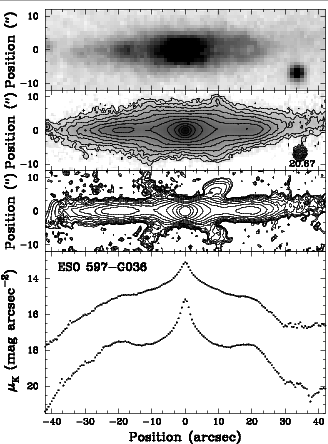
A paper describing this work has appeared in Bureau, M., Aronica, G., Athanassoula, E., Dettmar, R.-J., Bosma, A., & Freeman, K. C. 2006, MNRAS, 370, 733. You can also download it here in preprint format.
Together with my then DPhil student Michael Williams and Michele Cappellari (both University of Oxford), I also constructed models of the same sample of edge-on spiral and lenticular galaxies, to constrain their stellar and dark matter content. For each galaxy, we derived the stellar mass distribution from near-infrared photometry under the assumptions of axisymmetry and a constant K-band stellar mass-to-light ratio M/L. To this we added a dark halo assumed to follow a standard spherically symmetric Navarro, Frenk and White profile and a correlation between concentration and dark mass within the virial radius M_DM. We solved the Jeans equations for the corresponding potential under the assumption of constant anisotropy in the meridional plane, beta_z. By comparing the predicted second velocity moment to observed long-slit stellar kinematics, we determined the three best-fitting parameters of the model: M/L, M_DM, and beta_z. These simple axisymmetric Jeans models are able to accurately reproduce the wide range of observed stellar kinematics, which typically extend to 2-3 times the effective radius. We found a median stellar mass-to-light ratio at K-band of 1.09 Solar with an rms scatter of 0.31. Stellar population models predict slightly lower mass-to-light ratios. The mass models contain a median of 15 per cent dark matter by mass within an effective radius and 50 per cent within the optical radius. Dark and stellar matter thus contribute equally to the mass within a sphere of radius 4 times the effective radius or one time the optical radius. There is no evidence of any significant difference in the dark matter content of the spirals and S0s in our sample. Models without dark matter are also able to satisfactorily reproduce the observed kinematics in most cases, but the improvement when a halo is added is statistically significant, and the stellar mass-to-light ratios then better match the independent expectations of stellar population models.
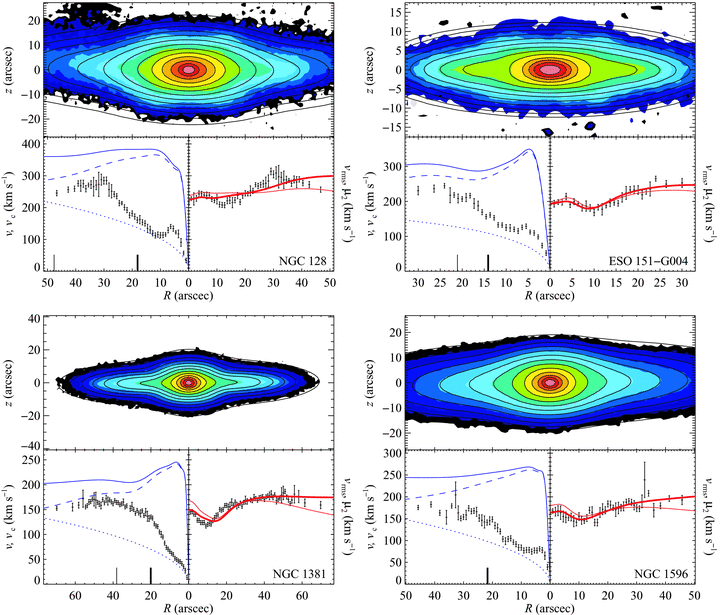
A paper describing this work has appeared in Williams, M. J., Bureau, M., & Cappellari, M. 2009, MNRAS, 400, 1665. You can also download it here in preprint format.
Again with my then DPhil student Michael Williams and Michele Cappellari (both University of Oxford), we built on the work described above to probe the Tully-Fisher (luminosity-rotation velocity) relations (TFRs) of lenticular (S0) and spiral galaxies. We demonstrated that, to accurately constrain the relative locations of the spiral and S0 TFRs, the same tracer and measure must be used for both galaxy types. Using detailed near-infrared imaging and the circular velocities of the axisymmetric Jeans models described above for 14 nearby edge-on Sa-Sb spirals and 14 nearby edge-on S0s drawn from a range of environments, we found that S0s lie on a TFR with the same slope as the spirals, but that they are on average 0.53 +/- 0.15 K magnitudes fainter at a given rotational velocity. This is a significantly smaller offset than that measured in earlier studies of the S0 TFR, which we attribute to our elimination of the bias associated with using different rotation measures and our use of earlier-type spirals as a reference. Since our measurement of the offset avoids systematic biases, it should be preferred over previous estimates. A spiral stellar population in which star formation is truncated would take approximately 1 Gyr to fade by 0.53 mag at K-band. If S0s are the products of a simple truncation of star formation in spirals, then this finding is difficult to reconcile with the observed evolution of the spiral/S0 fraction with redshift. Recent star formation could explain the observed lack of fading in S0s, but the offset of the S0 TFR persists as a function of both stellar and dynamical mass. We showed that the offset of the S0 TFR could therefore be explained by a systematic difference between the total mass distributions of S0s and spirals, in the sense that S0s need to be smaller or more concentrated than spirals.
With my then DPhil student Michael Williams ( University of Oxford), Michel Zamojski (now at IPAC), Michele Cappellari ( University of Oxford), Harald Kuntschner (ESO), Michael Merrifield (University of Nottingham), Tim de Zeeuw (ESO), and Konrad Kuijken (University of Leiden), we probed further the same sample of edge-on spirals and lenticulars. A handful of boxy and peanut-shaped bulges, including that of the Milky Way, have been observed to rotate cylindrically, i.e. with a mean stellar velocity independent of height above the disk. To assess whether cylindrical rotation is ubiquitous in boxy bulges, and whether a pure disk (with no classic bulge) interpretation is consistent with their stellar populations, we thus analysed the stellar kinematics and populations of a sub-sample of five boxy bulges selected from the sample of 30 discussed above. We placed slits along the major axis of each galaxy and at three offset but parallel positions to build up spatial coverage. The boxy bulge of the galaxy NGC3390 rotates perfectly cylindrically within the spatial extent and uncertainties of the data. This is consistent with the metallicity and alpha-element enhancement of the bulge, which are the same as in the disk. This galaxy is thus a pure disk galaxy. The boxy bulge of ESO311-G012 also rotates very close to cylindrical. The boxy bulge of NGC1381 is neither clearly cylindrically nor non-cylindrically rotating, but it has a negative vertical metallicity gradient and is alpha-enhanced with respect to its disk, suggesting a composite bulge comprised of a classical bulge and bar (and possibly a disky pseudobulge). The rotation of the peanut-shaped bulge of NGC5746 is difficult to classify, but the peanut-shaped bulge of IC4767 does not rotate cylindrically. Thus, even this relatively small sample is sufficient to demonstrate that boxy bulges display a range of rotational and population properties, indicating that they do not form a homogeneous class of object.
A paper describing this work has appeared in Williams, M. J., Zamojski, M. A., Bureau, M., Kuntschner, H., Merrifield, M. R., de Zeeuw, P. T., & Kuijken, K. 2011, MNRAS, in press. You can also download it here in preprint format.
Finally, I have also obtained optical imaging (BVI; SSO 40-inch telescope) for all sample galaxies and HI line-imaging (ATNF ATCA) for a subsample. Those data are not fully reduced however and the analysis is ongoing. The optical imaging will permit a limited study of the galaxies' stellar populations. I am currently working on the HI data with Albert Bosma (Observatoire de Marseille). Those will allow us to test the (gaseous) kinematic bar diagnostics with HI in very dusty systems and to study the environment of the galaxies, looking for evidence of interactions.
Gas Counter-Rotation:
Together with Aeree
Chung (Columbia
University), and using the ionized-gas and stellar kinematics
studies of the 30 edge-on disk galaxies discussed above, I have identified two new galaxies with gas
counter-rotation (NGC1596 and NGC3203) and have confirmed similar
behaviour in another one (NGC128). Gas counter-rotators thus represent
10+/-5% of our sample, but the fraction climbs to 21+/-11% when only
lenticular (S0) galaxies are considered and to 27+/-13% for S0s with
detected ionized-gas only. Those fractions are consistent with but
slightly higher than previous studies. A compilation from well-defined
studies of S0s in the literature yield fractions of 15+/-4% and
23+/-5%, respectively. Although mainly based on circumstantial
evidence, we argued that the counter-rotating gas originates primarily
from minor mergers and tidally-induced transfer of material from
nearby objects. Assuming isotropic accretion, twice those fractions of
objects must have undergone similar processes, underlining the
importance of (minor) accretion for galaxy evolution.
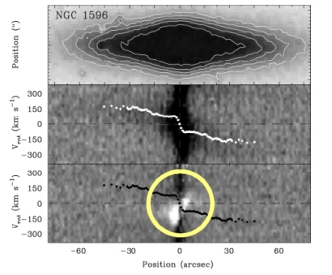
A paper describing this work has appeared in Bureau, M., Chung, A. 2006, MNRAS, 366, 182. You can also download it here in preprint format.
Following up on our discovery of counter-rotating ionized-gas, Aeree Chung (Columbia University) and I obtained Australia Telescope Compact Array (ATCA) HI imaging of the edge-on galaxy NGC1596. We found a large HI envelope associated with a nearby companion, the dwarf irregular galaxy NGC1602. The HI covers a region 11.9x13.4 arcmin^2 (62x70 kpc^2) and the total HI mass detected is 2.5+/-0.1x10^9 M_sun (assuming an 18 Mpc distance). The HI is centered on NGC1602 but has two tidal tails, one of which crosses over NGC1596. The HI located at the position of NGC1596 has a velocity gradient in the same sense as the ionized gas, i.e. opposite to the stellar rotation, strongly suggesting that the ionized gas in NGC1596 was accreted from NGC1602. From the length of the HI tails we conclude that the interaction started at least 1 Gyr ago, but the unsettled, asymmetric distribution of the ionized gas suggests that the accretion occured more recently. NGC1596 thus provides a good example where the presence of counter-rotating gas can be directly linked to an accretion event. After the accretion has stopped or the merging is complete, NGC1596 may evolve to a system with more extended counter-rotating gas but no obvious signature of interaction. There is also a substantial local HI peak in one of the two tails, where we also find a faint stellar counterpart. The M_HI/L_B ratio in this region is too high for a normal dwarf elliptical or a low surface brightness galaxy, so we concluded that a tidal dwarf is currently forming there.
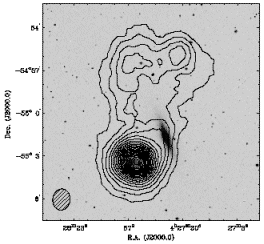
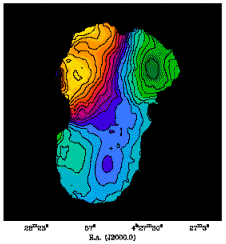
A paper describing this work has appeared in Chung, A., Koribalski, B., Bureau, M., & van Gorkom, J. H. 2006, MNRAS, 370, 1565. You can also download it here in preprint format.
SAURON: Bulges
In
Paper VII ( Falcon-Barroso et al. 2006,
MNRAS, 369, 529) of the SAURON Team, we
present observations of the stellar and gas kinematics for the
representative sample of 24 Sa galaxies of the SAURON survey, obtained
with our custom-built integral-field spectrograph operating on the
William Herschel Telescope. Our maps typically cover the
bulge-dominated region. We found a significant fraction of
kinematically decoupled components (12/24), many of them displaying
central velocity dispersion minima. They are mostly aligned and
co-rotating with the main body of the galaxies, and are usually
associated with dust discs and rings detected in unsharp-masked
images. Almost all the galaxies in the sample (22/24) contain
significant amounts of ionized gas which, in general, is accompanied
by the presence of dust. The kinematics of the ionized gas are
consistent with circular rotation in a disc co-rotating with respect
to the stars. The distribution of mean misalignments between the
stellar and gaseous angular momenta in the sample suggests that the
gas has an internal origin. The [O III]/Hbeta ratio is usually very
low, indicative of current star formation, and shows various
morphologies (ring-like structures, alignments with dust lanes or
amorphous shapes). The star formation rates (SFRs) in the sample are
comparable with that of normal disc galaxies. Low gas velocity
dispersion values appear to be linked to regions of intense star
formation activity. We interpret this result as stars being formed
from dynamically cold gas in those regions.
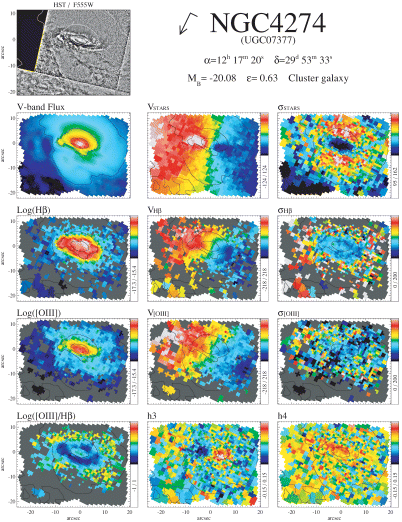
M31:
As part of a large collaboration led by Rachael Beaton
and Steve
Majewski (both at
University of Virginia), I carried out a detailed study of the
morphology of our neighbour galaxy M31 (Andromeda). A new 2.8 deg^2
JHKs near-infrared (NIR) survey from the 2MASS 6X program across
the extent of the optical disk of M31 provides a clear view of the
center of M31 almost completely unfettered by dust. Spectacularly, a
high-contrast bulge with very boxy isophotes dominates the NIR light
to a semi-major axis of about 700'' (2.6 kpc). The inner bulge
isophotes are relatively circular but show some twisting. Beyond this,
(1) the M31 bulge ellipticity increases, (2) its position angle is
constant (and about 10 degree higher than the position angle of the
disk), and (3) its boxiness increases to a degree comparable to other
renowned examples of boxy bulges observed in the NIR. In a
companion paper, self-consistent N-body simulations of a classical
bulge plus a bar with a boxy bulge were shown to reproduce the
observed NIR M31 features (see also bar
diagnostics). Beyond the boxy bulge region and nearly along the
position angle of the disk, a narrow ridge of NIR flux which can be
identified with the thin part of the bar more or less symmetrically
extends into the inner disk. Little variation in the morphology or
relative brightnesses of these various M31 structures is seen across
the NIR bands, i.e. there is no NIR color gradient. Most importantly,
these new data verify that M31 is a barred spiral galaxy just like the
Milky Way and the majority of disk galaxies in the local universe.
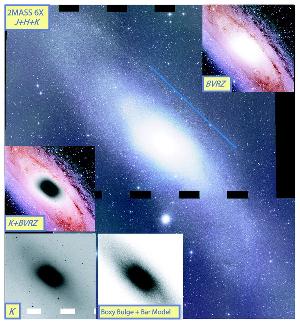
A paper describing this work has appeared in Beaton, R. L., et al. 2007, ApJL, 658, 91.You can also download it here in preprint format.
NGC7332:
Together with Jesus
Falcon-Barroso ( Leiden
University) and the SAURON team, I
carried out a detailed study of the S0 galaxy NGC7332. Existing
broad-band ground-based and HST photometry reveals a double-disc
structure and a boxy bulge interpreted as a bar viewed nearly
end-on. The SAURON
two-dimensional stellar kinematic maps confirm the existence of the
bar and inner disc but also uncover the presence of a cold
counter-rotating stellar component within the central 250 pc. The
Hbeta and [O III] emission line maps show that the ionized gas has a
complex morphology and kinematics, including both a component
counter-rotating with respect to the stars and a fainter corotating
one. The line-strength maps show that NGC7332 is young everywhere. The
presence of a large-scale bar can explain most of those properties,
but the fact that we see a significant amount of unsettled gas,
together with a few peculiar features in the maps, suggests that
NGC7332 is still evolving. Both interactions and bar-driven processes
must thus have played an important role in the formation and evolution
of NGC7332, and presumably of S0 galaxies in general.

A paper describing this work has appeared in Falcon-Barroso, J., et al. 2004, MNRAS, 350, 35. You can also download it here in preprint format.
To go back to my Home Page, click here:
![]()
This page was last modified on 14 April 2011